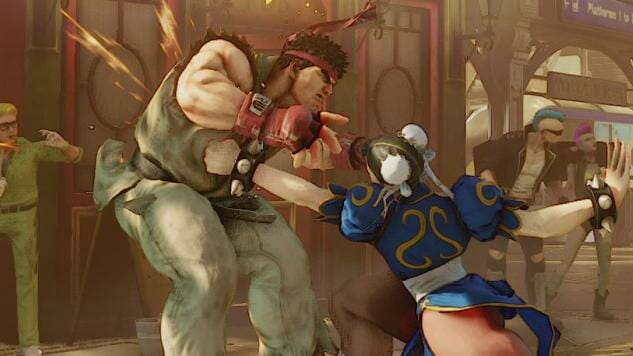
This weekend marks the 20th anniversary of the Evolution Championship Series, or EVO. A tournament with its roots firmly in Street Fighter, EVO 2016 is the greatest marker of growth yet for the quintessential World Cup of fighting games. Humble beginnings have swelled as more fighters have picked up the sticks, and this year, the Sunday Grand Finals won’t be held in a convention center or hotel ballroom, but the Mandalay Bay events center in Las Vegas.
In so many ways, EVO’s growth has been inextricably tied to Street Fighter. Despite efforts from Capcom and others to oust it, EVO has always been the main event for Street Fighter pros to face off and ultimately determine the world’s finest. It’s the perfect setting for storytelling in e-sports, with all entrants (pro and casual alike) competing in pools to advance into the main tournament bracket. Upsets, struggles, narratives, culture—EVO isn’t just a tournament, it’s a three-day celebration of all things FGC [fighting game community].
This year isn’t just different for the theatrics though—or rather, the grandeur underlies a greater truth about Street Fighter at EVO. Street Fighter V makes its EVO debut this year, in a year that hasn’t been kind to the series.
At launch, Street Fighter V was shaky. Lacking in story mode, basic multiplayer features and many of the other dressings you would come to expect from a studio so experienced in making quality fighting games, it seemed a mess. The notion was clear immediately: this was not a game polished and prepped, but released early in order to make the cut for the e-sports season.
Features have trickled down to the game in the months since release, but the focus is still clearly on ensuring the de facto reign of Street Fighter atop the FGC. Where Street Fighter IV represented some of the greatest growth in the series’ history, and a transition from arcades and handheld cameras to main stages and live broadcasts, Street Fighter V marks the question: can it go the distance?
This season of competitive Street Fighter has at least been dynamic. Many names have risen to the top and fallen just as fast, with strategies and character tier lists shifting every week. Street Fighter IV had time on its side; through so many iterations, the Super, Arcade, and Ultra updates that changed the scene every other year, a legacy was being built. Pros honed their skills, and amateurs struck at the top but often fell short of the pantheon, as the “gods” of Street Fighter IV were on another level.
But there are no gods in Street Fighter V. No match-up has been solved, no mechanics perfected, and players are learning new elements every day. The shimmies, the proper management of V-meter, the unblockables and unavoidables have yet to be completely cracked—and might consistently change over the game’s life, as, if we take Capcom at its word, Street Fighter V won’t be iterated on by Super and Ultra revisions, but adjusted through patches and online updates. Just two weeks prior to this year’s EVO, two completely new characters were introduced to the game, and both will be legal to play in the tournament. It’s an unheard-of change for the series, and endemic of the shift to a living, breathing game, rather than a series of landmark installments.
Yet despite the shift away from one of the most popular (competitively, at least) games in the series, Street Fighter V has been a point of bonding for much of the community. Before, Street Fighter often seemed unapproachable, an art that could be observed and analyzed, but entry was barred by an ever-increasing series of gatekeepers. The jargon, the focus on technique and skill, and the solely competitive focus was intimidating. It meant many would rather just stand back and admire the game than get involved, or even pick up a stick and start learning.
With Street Fighter V, that’s shifted. Players and commentators alike talk about how fun this game is to learn, to grow in and work at. There’s been a burst of growth in support structures and forums for learning, from reinvigorated subreddits to casual education channels on YouTube.
Even the events reflect this, highlighting the culture as an important part of tournaments. Community Effort Orlando 2016 was in a tough spot, held just two weeks after the horrible nightclub shootings in the city. The tournament became a rallying call, a reminder of the good that Street Fighter’s community can do and offering respite for those troubled by the events. As wrestling stars and passionate Street Fighter advocates Kenny Omega and Xavier Woods took the stage for an exhibition, the sentiment was clear—no matter your skill level, record or status, anyone who wants to be a part of the community can do so.
This weekend is bound to be an inflection point for Street Fighter V, and to shape our perception of the game to come. We’ll start to see whether this living model of Street Fighter works, if it was worth it to release the game early to make the cut for competitive over IV, and if it can be the main vehicle for competitive Street Fighter to come. Regardless, this entry has already done a great deal for the FGC, revitalizing a community and providing an even platform for players new and old to jump on and compete in massive tournaments like the Evolution Championship Series.
For every EVO, there’s always a Cinderella story, a player who climbs to the top eight, over pros and casuals alike, triumphantly succeeding and securing a bright future full of sponsorships, more tournaments and greater renown. Street Fighter V, for all its shortcomings as a game, will offer that much, at least.
EVO 2016 will run July 15 through 17, and can be streamed live on Twitch through the official EVO and Capcom channels.
Eric Van Allen is a Texas-based writer. You can follow his e-sports and games rumblings @seamoosi on Twitter.